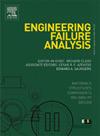高温高周变幅载荷下IN718断裂机理及寿命预测
IF 4.4
2区 工程技术
Q1 ENGINEERING, MECHANICAL
引用次数: 0
摘要
研究了变幅加载对高温下IN718高温合金甚高周疲劳行为的影响。在650℃下,对IN718高温合金进行了从低到高应力幅值(σL/H)和从高到低应力幅值(σH/L)条件下的VHCF试验。σL/H模态和σH/L模态的疲劳寿命分别呈上升趋势和下降趋势。通过对断口形貌和沿裂纹方向的显微组织特征分析,发现裂纹萌生区在两种模式下均倾向于在碳化物周围萌生裂纹,而在σH/L模式下高应力幅值导致的位错滑移活动增强是导致疲劳寿命缩短的主要原因。在裂纹尖端区域,σH/L模式下,裂纹倾向于在小扭转角(α)和小倾斜角(β)晶粒间扩展,低施密德因子的晶粒对裂纹扩展具有较高的抵抗性,而σL/H模式下,裂纹的微观组织呈无序分布。为了进一步实现寿命预测,建立了基于CatBoost算法的寿命预测模型,该模型优于经验方程,误差降低了近50%。本文章由计算机程序翻译,如有差异,请以英文原文为准。
Fracture mechanism and life prediction of IN718 under very high cycle variable amplitude loading at high temperature
This study investigates the effect of variable amplitude loading on the very high cycle fatigue (VHCF) behavior of IN718 superalloy at high temperature. VHCF tests are conducted on IN718 superalloy at 650 °C under low-to-high stress amplitude (σL/H) and high-to-low stress amplitude (σH/L) conditions. The σL/H mode and σH/L mode show an increasing trend and a decreasing trend in fatigue life, respectively. Through the analysis of fracture surface morphology and microstructural characteristics along cracks, in crack initiation region, cracks are found to tend to initiate around carbides for both modes while enhanced dislocation slip activity caused by high stress amplitude in the σH/L mode is the main reason for shortened fatigue life. In crack tip region, for σH/L mode, crack is found to tend to propagate between grains with small twist angle (α) and tilt angle (β) and grains with low Schmid factors show high resistance to crack propagation while disordered microstructures are observed for σL/H mode. To further realize life prediction, a model based on CatBoost algorithm is established and outperforms empirical equation with the error decreasing by nearly 50 %.
求助全文
通过发布文献求助,成功后即可免费获取论文全文。
去求助
来源期刊

Engineering Failure Analysis
工程技术-材料科学:表征与测试
CiteScore
7.70
自引率
20.00%
发文量
956
审稿时长
47 days
期刊介绍:
Engineering Failure Analysis publishes research papers describing the analysis of engineering failures and related studies.
Papers relating to the structure, properties and behaviour of engineering materials are encouraged, particularly those which also involve the detailed application of materials parameters to problems in engineering structures, components and design. In addition to the area of materials engineering, the interacting fields of mechanical, manufacturing, aeronautical, civil, chemical, corrosion and design engineering are considered relevant. Activity should be directed at analysing engineering failures and carrying out research to help reduce the incidences of failures and to extend the operating horizons of engineering materials.
Emphasis is placed on the mechanical properties of materials and their behaviour when influenced by structure, process and environment. Metallic, polymeric, ceramic and natural materials are all included and the application of these materials to real engineering situations should be emphasised. The use of a case-study based approach is also encouraged.
Engineering Failure Analysis provides essential reference material and critical feedback into the design process thereby contributing to the prevention of engineering failures in the future. All submissions will be subject to peer review from leading experts in the field.
 求助内容:
求助内容: 应助结果提醒方式:
应助结果提醒方式:


